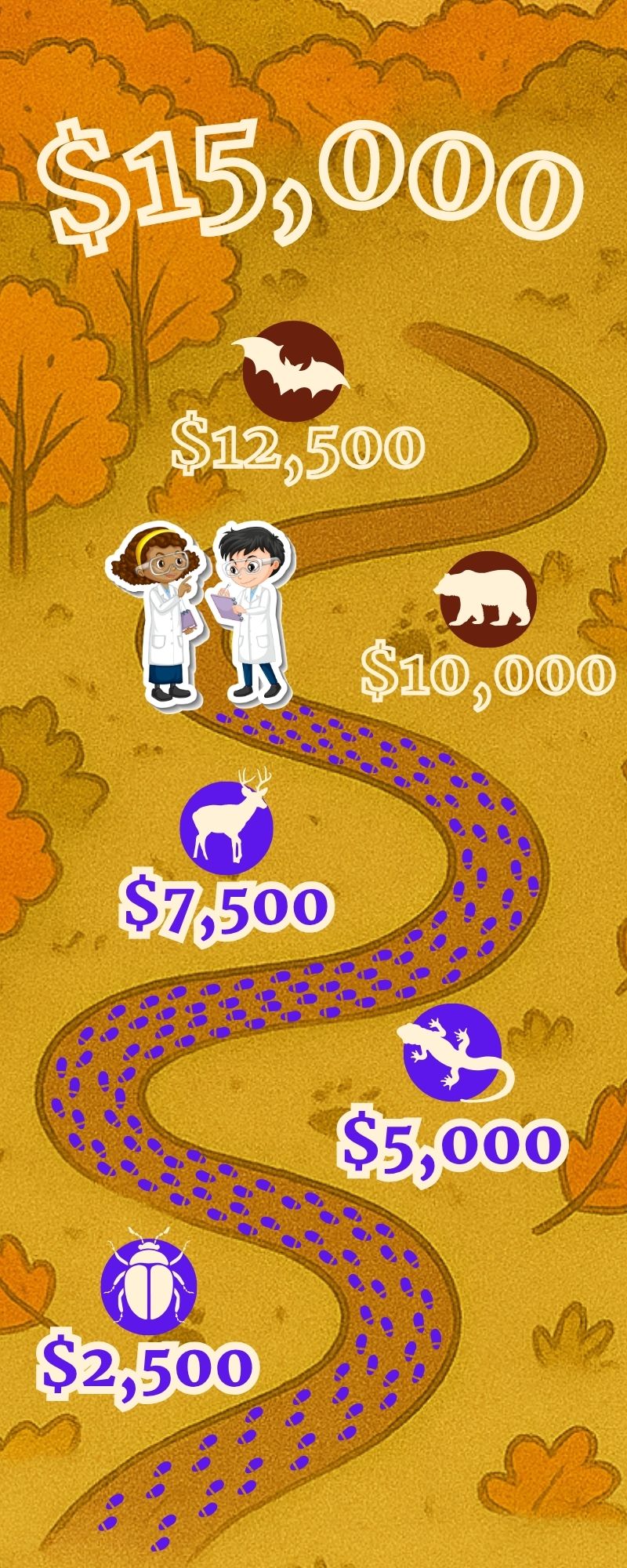
2025 Fall Campaign
Support Environmental Research
Every discovery starts with support from people like you. This fall, the Highlands Biological Foundation invites you to help us reach our goal of $15,000 to continue funding vital scientific research right here in the Southern Appalachians. From undergraduate students beginning their research journeys to established scientists leading long-term studies, your generosity fuels the next generation of discovery, conservation, and stewardship in one of the most biodiverse regions in North America.
Your gift supports:
Student Research Grants
Each year, HBF awards research grants to undergraduate and graduate students conducting fieldwork in the Southern Appalachians. These projects explore topics ranging from amphibian ecology to forest restoration and help launch young scientists into lifelong careers in conservation and environmental science.
Long-Term Ecological Studies
HBF supports ongoing projects that monitor the health of local ecosystems, such as bird banding and bat activity surveys. These studies provide essential data for understanding how wildlife populations change over time and how we can better protect them in the face of environmental challenges.
Collaborative Conservation Efforts
By partnering with universities, conservation organizations, and agencies, HBF helps connect science with action. These collaborations ensure that research findings directly inform restoration efforts, habitat protection, and community education across the Highlands-Cashiers Plateau and beyond.
Southern Appalachian Research
Funded by HBF Supporters Like You!
Monitoring wetland biodiversity following restoration through wildlife species presence and richness
Anna Boodée | Undergraduate | UNC-Chapel Hill
Anna’s research explores how restoring freshwater wetlands can benefit wildlife, focusing on two important bioindicator groups: bats and frogs. Using acoustic monitors, she tracked bat and frog activity over time on six wetlands in Franklin, North Carolina and compared activity on a restored site to activity at unrestored sites. She found that both bat and frog activity increased after restoration, and that the restored wetland had the greatest species diversity of both bats and frogs. As wildlife is increasingly threatened by habitat loss and degradation, these findings suggest that wetland restoration can be an effective strategy for wildlife conservation.
A comparative analysis of the role of cutaneous secretions in chemical communication in plethodontid salamanders
Paul Nicolosi | PhD Student | Ohio State University
Lungless salamanders (Plethodontidae) are key models for studying chemical communication. During courtship, males deliver pheromones that alter female behavior, and pheromone proteins are also found in skin mucus, which conveys information about species, sex, and reproductive status. This summer, Paul collected mucus from five additional species across three genera in the Highlands, sampling different sexes and reproductive states to study how these factors affect pheromone presence and types, providing insight into their evolutionary role in communication.
Microplastics in a southern Appalachian forest: Assessing connections between atmospheric deposition and terrestrial food chains
Erin Flanagan | Undergraduate | UNC-Chapel Hill
Erin and her colleagues are studying how atmospheric microplastics enter a Southern Appalachian forest food chain. At HBS, they analyzed microplastics in atmospheric deposition, earthworms, and shrews. Their findings show higher microplastic levels in shrews than in earthworms, with the highest concentrations in shrew hearts, and similarities across all sample types suggesting the atmosphere is a key source of pollution. To their knowledge, this is the first study to document microplastics in wild terrestrial animals in the southern U.S. and in shrews, and among the first to link atmospheric microplastics to those in wild animals.
MAPS Bird Banding
in partnership with Blue Ridge Bird Observatory
In 2025, Highlands Biological Station hosted the sixth consecutive season of Monitoring Avian Productivity and Survivorship (MAPS) banding in partnership with Blue Ridge Bird Observatory. Overall, total birds handled and species diversity decreased compared to 2024, with 20 species recorded this year.
Despite this, several species showed notable increases, including Slate-colored Junco, American Robin, and Black-and-white Warbler, each more than doubling in numbers. Some species experienced declines, such as Song Sparrow and Gray Catbird. Highlights for 2025 included the first-time banding of American Redstart and Orchard Oriole, while four neotropical migrant species present in 2024—Chestnut-sided Warbler, Louisiana Waterthrush, Black-throated Blue Warbler, and Red-eyed Vireo—were not recorded this year.
BatPack Project
Hannah Shepard | Research Assistant | UNC / WCU
This year, the BatPack project covered more than 70 miles along the Appalachian Trail from Georgia to Virginia, spending eight weekends studying bat activity across diverse terrain. Over 6,000 recordings were analyzed to evaluate activity levels, species diversity, and the presence of endangered species.
Endangered bats, including Gray, Northern Long-eared, and Indiana Bats, were recorded on half of the trips, highlighting the importance of the Appalachian Trail and local conservation efforts in supporting these species. The most active night occurred between Deep Gap and Dick’s Creek, with 770 identified recordings representing 9 of the 13 species found in western North Carolina.
Along the way, the team also witnessed the region’s rich wildlife, from bear cubs in the Smokies to foals in Grayson Highlands, and met countless hikers who made the journey even more memorable.
Thank you to our 2025 Fall Campaign donors:
Elizabeth & Richard Bruce
Catherine & Mike Carter
Amanda Chappell
Richard Crowell
Paul Fredrickson
Ken Gootee
Doris Gove
Barbara & Bob Gross
Lindy & Robert Harrison
John Helmer
Florence & Tom Holmes
Elizabeth & David Martin
David Millie
Constance Neely
Justine Simoni
Martha & Hal Stibbs
Lora Terry
Karen Vincent
Windee Willoughby
Your Support Makes a Lasting Impact
Every dollar brings us closer to understanding and protecting the incredible biodiversity of the Southern Appalachians. Join us in fueling research that inspires conservation and shapes the future of these mountains.


